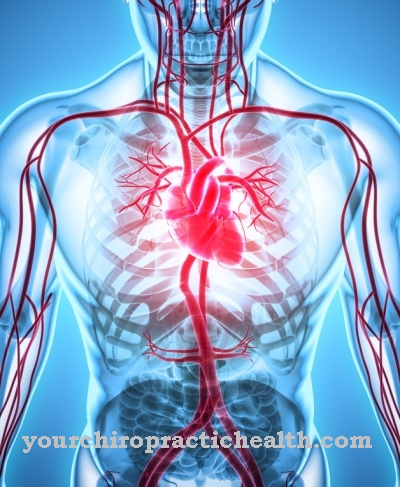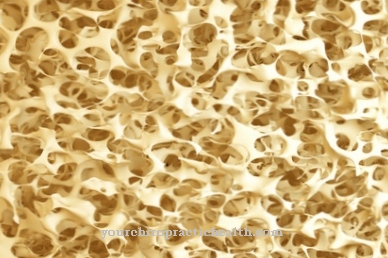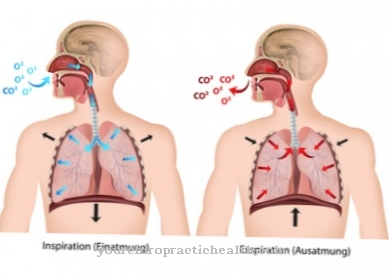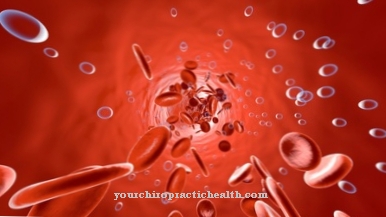The To swallow consists of a voluntary preparation phase, the swallowing reflex and the oral, pharyngeal and esophageal transport phase. This means that the swallowing process can only partially be deliberately controlled. Swallowing disorders are dysphagia and can be neurological, psychological or caused by diseases of the structures involved.
What is the swallow?

Swallowing is a complex sequence of movements. More precisely, the process corresponds to a perfectly coordinated contraction of certain muscles of the mouth, throat and throat. In addition to transporting food towards the stomach, swallowing also removes saliva. The swallowing process also cleanses the esophagus and removes any remaining stomach acid from the sensitive area. Humans experience up to 3000 swallowing processes per day. When asleep he swallows significantly less than when he is awake.
The act of swallowing consists of a voluntary preparatory part and the involuntary swallowing reflex. The irritation of individual areas at the base of the tongue is part of the voluntary preparation. The subsequent processes are beyond the control. Only the oral preparation phase and the oral transport phase can be deliberately influenced. The pharyngeal and esophageal transport phases are part of the involuntary swallowing reflex.
Function & task
The process of swallowing is carried out with the participation of various anatomical structures. In addition to the oral cavity and its border structures, the throat, larynx, esophagus and stomach are involved in swallowing. More than 20 muscle pairs play together in the act of swallowing. The coordination of these muscle pairs is subject to the control of the so-called swallowing center, which is mainly located in the brain stem and in the higher suprabulbar and cortical centers.
Several pairs of cranial nerves are relevant for the act of swallowing. In addition to the trigeminal nerve, the facial nerve, glossopharyngeal nerve, vagus nerve and hypoglossal nerve have important functions in swallowing. Humans need three cervical nerves to swallow. All three come from the spinal cord segments C1 to C3.
The swallowing reflex is a compulsory part of the swallowing process. The innate external reflex protects the airways and only enables safe food intake. The mucous membrane at the base of the tongue, on the throat or the back wall of the pharynx is stimulated in the preparatory phase and the mechanoreceptors located there conduct the stimulus via afferent fibers of the glossopharyngeal and vagus nerves into the medulla oblongata of the brainstem, which in turn receives the stimulus information by contacting the Swallowing muscles answered.
Interestingly, the size of the sip varies significantly from sip to sip and also depends on the type of food. 20 grams of aqueous pulp or 40 milliliters of liquid are the maximum per sip. The duration of swallowing can also vary greatly and depends primarily on the consistency of the bites and how they are mixed with saliva. The journey of a bite through the esophagus takes 20 seconds or less.
Each act of swallowing consists of three different transport phases and a preparatory phase, which is particularly relevant to the consumption of solid food. In the oral preparation phase, the bite of food is sufficiently chewed. The chopped up food is then infused with saliva so that it becomes slippery. In addition to the lips, teeth, the temporomandibular joint and the masticatory muscles, the tongue and the salivary glands are involved in the preparation phase. The act of swallowing is only possible once the preparatory phase has been completed.
In the subsequent phase of oral transport, the lips close completely. This prevents saliva loss. In addition, no air should be swallowed. The cheek muscles contract and the tongue migrates to the hard palate, which takes on an abutment function. The bolus moves backwards in a wave-like movement and is supported by the styloglossus and hyoglossus muscles. The tongue pulls backwards like a stamp and pushes itself into the throat. The swallowing reflex is only triggered when the base of the tongue is touched by the bite. The process can only be partially influenced from the swallowing reflex.
You can find your medication here
➔ Medicines for sore throats and difficulty swallowingIllnesses & ailments
Medicine calls any disorders of the act of swallowing dysphagia. The structures involved in the act are either impaired in their function or their interaction does not work sufficiently. All diseases of the oral cavity, its limitations, diseases of the throat, those of the esophagus and those of the stomach entrance can be associated with swallowing disorders.
Also, neurological problems are often associated with swallowing problems. One example of this is ALS. By decomposing the motor cranial nerve nuclei, ALS paralyzes the body's muscles step by step. This creates swallowing disorders and bulbar symptoms. Patients regularly choke on their own saliva and are often treated with salivary medication.
Patients with the autoimmune disease multiple sclerosis often suffer from neurological dysphagia, which is caused by autoimmune inflammation in the swallowing center of the brain. Swallowing disorders are sometimes caused by mental disorders.
If the dysphagia also causes pain symptoms, it is called odynophagia. Possible symptoms are a feeling of pressure in the throat, a gag reflex when swallowing, a cough during meals, the aspiration of food components and an overproduction of saliva. Accompanying symptoms, patients with dysphagia often complain of nasal language and general hoarseness. When food is aspirated, pneumonia with fever is common.
Dysphagia can be an age-physiological phenomenon and in this case manifest itself primarily in people over the age of 75. This type of dysphagia is mostly due to neurological, psychiatric or general chronic diseases in old age. Not every patient needs to be aware of a swallowing disorder.












.jpg)



.jpg)










.jpg)
